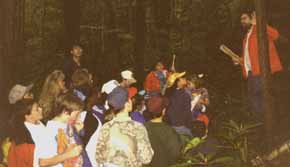
On April 22nd of 1998 Tom Rogers and I went trekking into the Curtis Creek area of Mackey Mountain with 23 4th graders from Old Fort Elementary, their teacher Mrs. Turner, and two chaperones. The purpose of the excursion was to introduce the students to the amazing natural resource that is right in their backyard. Rob Messick, an employee of the Western North Carolina Alliance who has done much old growth inventorying in the Mackey Mountain area as well as throughout the Pisgah National Forest, met us at the trail head to serve as our guide.
Tom and I had visited with the class prior to the trip to provide them with some background on the area and to help them better understand the importance of old growth forests. We kept our talk brief and were quite impressed with the quality of questions that the students asked. Though there seemed to be much excitement abut whether or not they were going to be able to get in the water during the hike, it was obvious that the students were also interested in exploring the area to get a close-up look at some of these older and larger trees.
The morning of the 22nd came and, despite dark skies, the bus left the school for the Curtis Creek campground. The students were energetic about getting into the woods (as anyone can imagine or remember from when they were ten) - the idea of getting out of the classroom and into the woods also appealed to Mrs. Turner, Tom, and me. We met Rob at the campgrounds, made introductions and got on our way into the forest. There was much to keep the students occupied during the hike including the creek, countless wildflowers, and various insects. After a half-hour or so we came to the area where logging had stopped and Rob explained the differences in the forest types we were observing. Young poplar trees dominated the area that had been logged, whereas the area which had remained relatively untouched had a variety of trees including maples, basswood, hemlock, oaks, and hickory. This area of older trees was much darker due to the denser canopy with a more open understory. The line where one forest type ended and the other began was obvious and the students were able to actually see the difference between a heavily timbered area and one that had, for the most part, been untouched. At the same time they were seeing this difference Rob was explaining how this transformation occurred.

We reached the first set of cascades, our stopping point, and Rob set about discussing the importance of our remaining old growth stands. Time limited his discussion, as did attention span, but he was able to convey the need for these areas and the variety of species for which they provide habitat. He also passed around a few core samples along with magnifying lenses in order for the students to get a firsthand look at how a tree is dated. Sufficiently impressed and full of new knowledge, it was time to head back down the trail. We reached the bus about 45 minutes later - a little more exhausted and much wetter - and headed back to school.

Field trips such as this one allow for a hands-on understanding of just how amazing these areas are and why they deserve special attention and conservation. Instilling at an early age an appreciation for the natural treasures in our own backyards is essential if we are going to maintain and preserve them.
We look forward to continuing our work with the Old Fort Elementary School in the fall. Many thanks to Mrs. Turner and her students as well as Rob Messick for an enjoyable and informative morning in the old growth of Mackey Mountain.